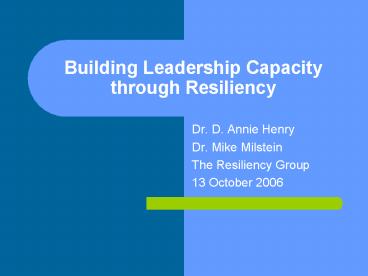Building Leadership Capacity through Resiliency - PowerPoint PPT Presentation
1 / 21
Title:
Building Leadership Capacity through Resiliency
Description:
Building Leadership Capacity through Resiliency Dr. D. Annie Henry Dr. Mike Milstein The Resiliency Group 13 October 2006 How we spend our days is, of course, how ... – PowerPoint PPT presentation
Number of Views:482
Avg rating:3.0/5.0
Title: Building Leadership Capacity through Resiliency
1
Building Leadership Capacity through Resiliency
- Dr. D. Annie Henry
- Dr. Mike Milstein
- The Resiliency Group
- 13 October 2006
2
How we spend our days is, of course, how we
spend our lives."
- Annie Dillard, American author and Nobel Prize
recipient
3
I shall be telling this with a sighSomewhere
ages and ages hence two roads diverged into a
woods,And II took the one less traveled by,
and that has made all the difference. By
Robert Frost
4
(No Transcript)
5
(No Transcript)
6
(No Transcript)
7
(No Transcript)
8
I dwell in possibilities.
- Emily Dickinson
9
What doesnt kill me makes me stronger.
- Nietzsche
10
Internal Protective Factors
- Gives of self in service to others or a cause or
both. - Uses life skills, including good decision making,
assertiveness, impulse control, and problem
solving. - Is sociable and has ability to be a friend and
form positive relationships. - Has a sense of humor.
- Exhibits internal locus of control, i.e., belief
in ability to influence ones environment. - Is autonomous, independent.
- Has positive view of personal future.
- Is flexible.
- Has spirituality, i.e., belief in a greater
power. - Has capacity for connection to learning.
- Is self-motivated.
- Is good at something, has personal competence.
- Has feelings of self-worth and self- confidence.
11
Environmental Protective Factors
- Promotes close bonds.
- Values and encourages education.
- Uses high warmth, low criticism style of
interaction. - Sets and enforces clear boundaries (rules, norms,
and laws). - Encourages supportive relationships with many
caring others. - Promotes sharing of responsibilities, service to
others, required helpfulness. - Provides access to resources for meeting basic
needs of housing, employment, health care, and
recreation. - Expresses high realistic expectations for
success. - Encourages goal setting and mastery.
- Nourishes development of positive connections
(such as altruism) and life skills (such as
cooperation). - Provides leadership, decision making, and other
opportunities for meaningful participation. - Appreciates the unique talents of each
individual.
12
Resilient Response
Adversity
Return to Comfort Zone
Survival
Dysfunctional Response
Figure 1 Multiple Ways to Respond to Adversity
13
Resiliency Definitions
- The process of coping with disruptive, stressful,
or challenging life events in a way that provides
the individual with additional protective and
coping skills. (Richardson, Neiger, Jensen,
Krumpfer, 1996) - The process of self-righting and growth.
(Higgins, 1994) - The capacity to bounce back, withstand
hardships, and to repair yourself. (Wolin
Wolin, 1993)
14
The Six Resiliency Elements
15
(No Transcript)
16
For most of us is not that our aim is too high
and we miss it, but that our aim is too low and
we reach itMichelangelo
17
Strategies that Promote Leadership Resiliency
- Positive Connections
- Shared decision making
- Participation in professional development
- mentor
- Clear, Consistent Appropriate Boundaries
- Involve educators and students to set rules
policies - Communicate policies in writing
- Check for clarity
- Norms that are clear understood and shared
18
Strategies Continued
- Life Guiding Skills
- Survey staff members
- Model adult learning principles
- Obtain resources and support
- Nurture and Support
- Purposeful and regular feedback
- Celebrations and recognitions
- Discouraging negative criticism
19
Strategies Continued
- Purposes and Expectations
- Involve others in development of vision, mission
and goals - Create ongoing planning and actions teams
- Communicate progress and problems
- Meaningful Participation
- Promote teams
- Develop skills to motivate and facilitate process
- Promote cooperative efforts
20
If the fish in a stream were dying, we would not
assume that we could solve this problem by
pulling the fish out of the stream and allowing
them to swim in a clean fish tank for 30 minutes
each day, returning them to the original system
for the remainder of the day. We would begin a
systematic search to find out what was causing
the fish to die. Solutions might be a combination
of cleaning up the stream, educating the users of
the stream, and spending money differently to
respond to the problem. If the health of the fish
were important to us, we would do what was
necessary to restore the health of the stream so
the fish could thrive. Mary Taylor, Ph.D.
21
Even if youre on the right track youll get run
over if you just sit there. Will Rogers































